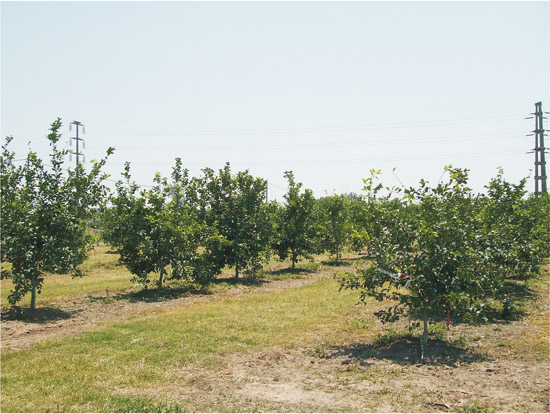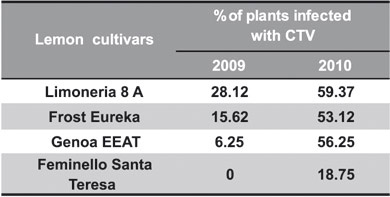Servicios Personalizados
Revista
Articulo
Indicadores
-
 Citado por SciELO
Citado por SciELO
Links relacionados
-
 Similares en
SciELO
Similares en
SciELO
Compartir
Revista industrial y agrícola de Tucumán
versión On-line ISSN 1851-3018
Rev. ind. agric. Tucumán vol.89 no.1 Las Talitas ene./jun. 2012
ARTÍCULOS ORIGINALES
Natural spread of Citrus tristeza virus in lemon varieties*
Julia Figueroa**, Lucas Foguet**, Cecilia Escobar Ponce de León**, Florencia Palacios**, Gustavo Martos**, and Beatriz Stein**
* Paper published in the Proceedings of the 18th Conference of the International Organization of Citrus Virologists, 2011.
** Centro de Saneamiento de Citrus, EEAOC. saneamiento@eeaoc.org.ar
Abstract
Natural spread of Citrus tristeza virus (CTV) was monitored in different lemon varieties derived from shoot tip grafted (STG) selections proven to be free of CTV before planting. The trial was planted in November, 2007, with a randomized four-block design with four replications. This experiment was originally established to compare selected clones with their duplicates recovered by STG. The selected clones were originally nucellar clones kept in the germplasm bank in the field for 30 to 40 years, so the plants were naturally infected with CTV. The lemon varieties tested were two lines of both Frost Eureka and Limoneira 8A Lisbon and one line of Feminello Santa Teresa and Genoa EEAT. Plants were grafted on Poncirus trifoliata Flying Dragon, except for Eureka lemon, which was grafted on 79 AC [Citrus reshni x (C. paradisi x P. Trifoliata)]. Direct immunoprinting-ELISA with 3DF1+3CA5 monoclonal antibodies (Plant Print Diagnostics, Valencia) was used to determine the presence of CTV in field samples. Each sample was composed of four young shoots collected from the four sides of each tree. Two diagnoses were performed, one in September 2009 and another in September 2010. STG trees showed significant differences in CTV infection among them. The variety most infected with CTV was Limoneria 8 A and the least infected was Feminello Santa Teresa. Infected plants were found in a random distribution in the plot. All selected lemon trees were CTV positive. CTV spread will be monitored until 100% of all varieties show positive.
Tristeza disease has been present in Argentina since 1930 (Zeman, 1931) and the most efficient vector, Toxoptera citricida, and other aphids are also present. Consequently, the disease is endemic. The purpose of this work was to monitor Citrus tristeza virus (CTV) spread in a virus-free lemon plot. The plot, located in Tucuman province, was planted in November 2007 with a randomized four-block design with four replications (Figure 1). This trial was established originally to compare selected clones with their duplicates recovered by shoot-tip grafting (STG). The selected clones were nucellar clones but kept in the germplasm bank in the field for 30 to 40 years, so the plants were naturally infected with tristeza. STG trees proved to be free of CTV, psorosis, citrus variegated chlorosis (CVC) and citrus viroids before planting. Lemon varieties tested were selected clones and STG plants of two lines of both Frost Eureka and Limoneira 8A Lisbon and one line of Feminello Santa Teresa and Genoa EEAT. Plants were grafted on Poncirus trifoliata Flying Dragon except for Eureka lemon, which was grafted on 79 AC [Citrus reshni x (Citrus paradise x Poncirus trifoliata)] because of its incompatibility with trifoliate orange. Tristeza spread was monitored yearly indexing all trees by direct immunoprinting-ELISA using 3DF1+3CA5 monoclonal antibodies (Plant Print Diagnostics, Valencia) (Cambra et al., 2000). Two diagnoses were performed, one in September 2009 and another in September 2010. Each tree was sampled by collecting four young shoots about 10 cm to 15 cm long, from around the canopy at a height of approximately 1.5 m.

Figure 1. Lemon trees planted in a randomized-plot design to study natural transmission of Citrus tristeza virus (CTV).
Yield was recorded and tree size was evaluated by measuring trunk circumference, tree height and canopy volume. Additionally, peel oil yield was evaluated. The trees were only three years old and thus the data is limited, but it will continue to be collected.
The first monitor in 2009 showed differences in CTV infection among the lemon cultivars. Feminello Santa Teresa was the only cultivar with no CTV infection. Genoa EEAT had the least infection, with only one side of one tree CTV positive (6.25%), and the most infected cultivar was Limoneira 8A, with 28.12% of the plants infected in all sides sampled (Table 1). In the second monitor (2010) all lemon cultivars tested positive for CTV. Limoneira 8 A Lisbon, Frost Eureka and Genoa EEAT had more than 50% of plants infected, while Feminello Santa Teresa had 18.75% of CTV infected plants (Table 1).
Table 1. Percentage of CTV infected plants in a lemon trial in Argentina, 2009 and 2010.

CTV infected plants were distributed randomly in the plot, which probably means that position has no influence on spread, as previously stated (Gottwald et al., 1993). Distribution of lemon cultivars in the block and location of CTV positive plants are illustrated in Figure 2. CTV spread will be monitored until 100% of the plants of the trial test positive.

Figure 2. Distribution of lemon cultivars in the test orchard and location of CTV positive trees.
(Lim.=Limoneira; Fr. Eur.= Frost Eureka; F. Sta. Teresa= Feminello Santa Teresa). Nucellar lines: 1- Fr. Eur.; 2- Lim. 8A; 3- F. Sta. Teresa; 4- Genoa EEAT. Yellow blocks CTV positive 2009; blue blocks CTV positive 2009 and 2010; no color: CTV negative.
Conclusions
- All selected lemon clones were CTV positive, while their STG duplicates showed differences in CTV incidence and progress.
- Among STG trees, the lowest infection rate was obtained in Feminello Santa Teresa cultivar.
- There was a significant increase in CTV infection on Genoa EEAT between 2009 and 2010.
- Although in the first year there were differences in CTV incidence among lemon cultivars in a very short period of time, these differences tended to disappear by the second year.
Cited references
1.Cambra, M.; M. T. Gorris; M. P. Román; E. Terrada; S. M. Garnsey; E. Camarasa; A. Olmos and M. Colomer. 2000. Routine detection of Citrus tristeza virus by direct immunoprinting-ELISA method using specific monoclonal and recombinant antibodies. In: Proc. Conf. IOCV, 14, Riverside, CA, USA, pp. 34-41. [ Links ]
2.Gottwald, T. R.; M. Cambra and P. Moreno. 1993. The use of serological assays to monitor spatial and temporal spread of Citrus tristeza virus in symptomless trees in eastern Spain. In: Proc. Conf. IOCV, 12, Riverside, CA, USA, pp. 51-68. [ Links ]
3.Zeman, V. 1931. Una enfermedad nueva en los naranjales de Corrientes. Physis 19: 410-411. [ Links ]














